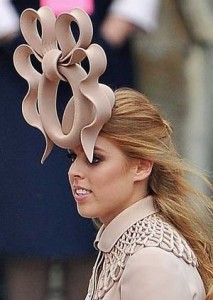When American Pharoah won the Triple Crown, a lot of us reached for our dictionaries as well as our superlatives. Yes, yes, we know, we know: his name is spelt wrong (or wrongly?). But that’s another story, and not the only interest Glossophilia has in horse-racing. There’s something else that fascinates us about the races, and that’s what the spectators wear on their heads: the fascinator.
As well as being a word that describes a person such as yourself (isn’t everyone an irresistibly attractive or charming person in their own way?), what exactly does fascinator mean? Here’s a clue: Princess Beatrice wore one to the royal wedding in 2011. And you’ll see a lot of them in the coming days at Royal Ascot in Windsor, where the hats and horses are at it again. But you don’t have to be loud, ugly or weird to be a fascinator; “whimsical” (Encyclopedia Brittanica), “frothy” (History) and “frivolous” (WordSense) have all been used to describe and define the ever-evolving and now effervescent headgear. It’s a hat that has effectively grown into its very name, with humble beginnings — when it was far from fascinating — a couple of centuries ago. It’s also an accessory we tend to associate with posh Brits at weddings or at the races, but you might be surprised to learn where (geographically) the fascinator was first given its name: it wasn’t in the royal box at Windsor.
During the fascinator frenzy that followed the wedding of the 21st century when Princess Beatrice donned her famous toilet-seat affair, Grammarphobia took a look at the early history of the headpiece:
“Since we associate fascinators with British women, it’s interesting that the word “fascinator” in the sense of headwear first appeared in 19th-century America. Back then, though, a fascinator wasn’t as flashy as it is today. The Oxford English Dictionary describes the early “fascinator” as “a head shawl worn by women, either crocheted or made of a soft material.” The term first showed up in print, the OED says, thanks to another Kate. In a letter written in 1878, the author Kate Douglas Wiggin recalled “Mother crocheting a fascinator.” In another citation, the Sears, Roebuck catalogue for 1897 offered a “Ladies’ Fascinator, made of good quality Shetland yarn … colors, pink and white.” The dictionary’s other citations for that early sense of “fascinator” extend into the 1960s, so it’s likely that the meaning of the old word was simply updated. The OED doesn’t explain why those early head shawls were called fascinators, but we can guess.”
In 2009, Fritinancy looked at how and when the modest knitted headscarf came out of its shell, added a bit of pizazz, and started to grab its own attention on the heads of society ladies at weddings and at the races. Quoting Elaine Higgleton, editorial director of the Collins Language Division, in a 2008 interview, Fritinancy explains: “At some point in the mid-20th century “fascinator” slipped out of use … and then reappeared with a new meaning. … It’s originally a very fine or lacy wool or lace head-shawl that a lady might wear over her head going out in the evening with her evening clothes. So it’s something fine that you wear on your head. And as a word, that had pretty much fallen out of use by about 1969, the late 1960s, early 1970s. But it’s made a real comeback in the last couple of years, because fascinator is the term that’s now being used to describe the little, tiny headpieces that a woman might wear at something like a wedding, or if she goes to the races. They’re made out of lace with feathers and flowers. Quite elaborate confections. Very delicate and frivolous-looking. And that’s an example of a word that had a very valuable use, that kind of died away—people didn’t use the word for anything—and it’s been resurrected with a slightly new meaning. So it’s [sic] usage has been extended now to still mean something that women wear on their heads that’s fine and delicate, but it’s not a shawl anymore; it’s more of a hat-like confection.”
Thanks, Barbara, for the “hat-tip”. Boom boom.

